20 apr 2018
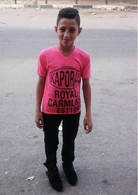
Mohammed Ayyoub, 15 video
Four Palestinians were killed and 645 injured by Israeli gunfire while taking part in the 4th Friday of the Great March of Return in Gaza.
Spokesman for Gaza's Ministry of Health Ashraf al-Qedra announced that Ahmad Aqel, 25, Ahmad al-Athamna, 24, Mohammed Ayyoub, 15, and Sa'd Abu Taha were killed after being shot by Israeli snipers during the protests.
About 645 Palestinians were injured including 29 children and 13 women, according to the Ministry.
Four Palestinians were killed and 645 injured by Israeli gunfire while taking part in the 4th Friday of the Great March of Return in Gaza.
Spokesman for Gaza's Ministry of Health Ashraf al-Qedra announced that Ahmad Aqel, 25, Ahmad al-Athamna, 24, Mohammed Ayyoub, 15, and Sa'd Abu Taha were killed after being shot by Israeli snipers during the protests.
About 645 Palestinians were injured including 29 children and 13 women, according to the Ministry.
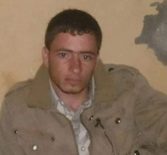
Sa'd Abu Taha 32
The latest deaths brought the number of the Palestinians killed since the launch of the Great March of Return on 30th March to 39, two of whom are being detained by the Israeli forces. Nearly 4,279 have been injured so far.
The PIC reporter said that the Palestinian youths managed to remove a large part of the border fence erected east of Khan Younis in the southern Gaza Strip.
Dozens of tires were set on fire during the protests, while some Hebrew media sources reported that fires erupted in some fields neighboring the Gaza Strip after a group of youths flew kites with flaming rags dangling from their tails over the border areas.
Meanwhile, Israeli planes dropped leaflets near al-Awda (return) camps along the border fence warning the Palestinian people against participating in the March of Return and claiming that Hamas exploits them to carry out "terrorist attacks".
The latest deaths brought the number of the Palestinians killed since the launch of the Great March of Return on 30th March to 39, two of whom are being detained by the Israeli forces. Nearly 4,279 have been injured so far.
The PIC reporter said that the Palestinian youths managed to remove a large part of the border fence erected east of Khan Younis in the southern Gaza Strip.
Dozens of tires were set on fire during the protests, while some Hebrew media sources reported that fires erupted in some fields neighboring the Gaza Strip after a group of youths flew kites with flaming rags dangling from their tails over the border areas.
Meanwhile, Israeli planes dropped leaflets near al-Awda (return) camps along the border fence warning the Palestinian people against participating in the March of Return and claiming that Hamas exploits them to carry out "terrorist attacks".
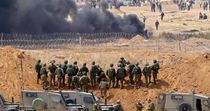
Jamie McGoldrick, the United Nations humanitarian coordinator, called on Friday for the protection of Palestinian demonstrators in Gaza alongside support for urgent humanitarian needs.
McGoldrick called for the protection of Palestinian demonstrators and for urgent funding to meet critical humanitarian needs that have been generated by the massive rise in Palestinian casualties in Gaza since 30 March.
"The current surge in humanitarian needs is a crisis on top of a catastrophe. As we approach another Friday of demonstrations near the perimeter fence between Gaza and Israel, it is critical that the Israeli authorities exercise the utmost restraint in the use of force for law enforcement operations, in line with their obligations under international law."
McGoldrick explained that humanitarian partners urgently need $5.3 million in funding to meet emerging health, psycho-social and protection needs until 31 May 2018.
“These funds are required to enable the deployment of specialized medical teams to conduct complex, lifesaving surgeries; for medicines to prevent avoidable death or disability; to allow blood banks to immediately increase their capacity to cope with the high volume of trauma casualties, among a range of other critical health needs. Funding is also required to ensure that victims of violence and their families receive essential mental health and psycho-social support and to support organizations monitoring, verifying and documenting possible protection violations.”
"Gaza's essential service providers simply do not have the capacity, at present, to cope with the current situation" said McGoldrick. "The humanitarian community stands ready to support the State of Palestine in meeting the immense health needs of Palestinians in Gaza, and ensuring that vital protection and mental health support is available."
McGoldrick called for the protection of Palestinian demonstrators and for urgent funding to meet critical humanitarian needs that have been generated by the massive rise in Palestinian casualties in Gaza since 30 March.
"The current surge in humanitarian needs is a crisis on top of a catastrophe. As we approach another Friday of demonstrations near the perimeter fence between Gaza and Israel, it is critical that the Israeli authorities exercise the utmost restraint in the use of force for law enforcement operations, in line with their obligations under international law."
McGoldrick explained that humanitarian partners urgently need $5.3 million in funding to meet emerging health, psycho-social and protection needs until 31 May 2018.
“These funds are required to enable the deployment of specialized medical teams to conduct complex, lifesaving surgeries; for medicines to prevent avoidable death or disability; to allow blood banks to immediately increase their capacity to cope with the high volume of trauma casualties, among a range of other critical health needs. Funding is also required to ensure that victims of violence and their families receive essential mental health and psycho-social support and to support organizations monitoring, verifying and documenting possible protection violations.”
"Gaza's essential service providers simply do not have the capacity, at present, to cope with the current situation" said McGoldrick. "The humanitarian community stands ready to support the State of Palestine in meeting the immense health needs of Palestinians in Gaza, and ensuring that vital protection and mental health support is available."
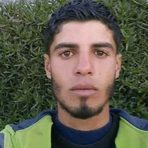
Ahmad Rashad al-Athamna, 24
The Palestinian Health Ministry has reported, Friday, that Israeli soldiers killed two Palestinians, and injured at least seven others, including a journalist, and a medic, who was shot in the head, in the Gaza Strip.
It said the soldiers shot and killed a young man, identified as Ahmad Rashad al-Athamna, 24, in the northern part of the Gaza Strip.
The Palestinian Health Ministry has reported, Friday, that Israeli soldiers killed two Palestinians, and injured at least seven others, including a journalist, and a medic, who was shot in the head, in the Gaza Strip.
It said the soldiers shot and killed a young man, identified as Ahmad Rashad al-Athamna, 24, in the northern part of the Gaza Strip.
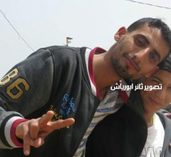
Ahmad Nabil Abu Aqel, 25
The army also killed Ahmad Nabil Abu Aqel, 25, from Jabalia in northern Gaza, after shooting him with a live round in the head.
The Ministry said the soldiers shot five Palestinians, including a medic who was shot with a live round in the head, and a journalist who was wearing a clearly marked press vest and helmet, east of Khuza’a town, east of Khan Younis, in the southern part of the Gaza Strip.
It added that the soldiers also two other Palestinians with live fire east of Rafah, in southern Gaza. One of them was shot in his knee, and the other was shot in his thigh.
The Ministry stated that he was shot with a live round in the head. He died approximately two hours after being shot.
The soldiers also shot three other Palestinians who were rushed to local hospitals.
Updated From:
Army Injures Two Palestinians In Northern Gaza
Israeli soldiers shot, Friday, two young Palestinian men with live fire, including one who suffered a serious head injury, after the army attacked protesters east of Jabalia, in the northern part of the Gaza Strip.
Palestinian medical sources said the seriously wounded young man, Ahmad Nabil al-‘Aqel, was shot with a live round in the head, and was rushed to the Indonesian Hospital, in Beit Lahia.
The two Palestinians were injured just as hundreds of Palestinians marched on their lands, near the border fence, on the fourth week of the “Great March of Return.”
Hundreds of Palestinians started gathering near the border fence, demanding their internationally-guaranteed Right of Return.
The protests started on March 30th, which marks the Palestinian Land Day, and are planned to continue until May 15th, the 70th anniversary of the Palestinian Nakba (Catastrophe), in which more than 700,000 Palestinians were forcibly displaced by Israeli forces in 1948, and their villages and towns were destroyed, prior to the establishment of Israel in historic Palestine.
The army killed at least 34 Palestinians, and injured thousands or protesters since the nonviolent protests started on March 30th.
Palestinian injured at daybreak on 4th week of Great March of Return
A Palestinian young man was shot and injured by the Israeli occupation forces on Friday morning east of Khuza’a town, in Khan Younis.
Reporting from Khan Younis, a PIC news correspondent said the Israeli military targeted at daybreak a group of Palestinian youths peacefully gathering near the Awda camp in Khuza’a, to the east of Khan Younis, with spates of bullet fire.
A young man was rushed to a hospital so as to be urgently treated for the wounds inflicted by the Israeli attack.
At the same time, threatening leaflets were dropped by Israeli planes on the Awda (return) tents set up near al-Bureij refugee camp, in the central Gaza Strip, and Jabaliya, to the north, as part of Israeli attempts to rein in participation in the Great March of Return under the pretext that it is staged by Hamas.
The National Authority for the March of Return said it moved its protest tent camps 50 meters closer to the eastern border fence with the Israeli-occupied territory, amid fears of fresh violence on the fourth week of Great Return March protests.
At least 35 Palestinians were killed and 4,200 others injured since a tide of violence broke out on March 30 along Gaza’s border area as the Israeli military aggressively attacked Palestinians taking part in the Great March of Return events.
The army also killed Ahmad Nabil Abu Aqel, 25, from Jabalia in northern Gaza, after shooting him with a live round in the head.
The Ministry said the soldiers shot five Palestinians, including a medic who was shot with a live round in the head, and a journalist who was wearing a clearly marked press vest and helmet, east of Khuza’a town, east of Khan Younis, in the southern part of the Gaza Strip.
It added that the soldiers also two other Palestinians with live fire east of Rafah, in southern Gaza. One of them was shot in his knee, and the other was shot in his thigh.
The Ministry stated that he was shot with a live round in the head. He died approximately two hours after being shot.
The soldiers also shot three other Palestinians who were rushed to local hospitals.
Updated From:
Army Injures Two Palestinians In Northern Gaza
Israeli soldiers shot, Friday, two young Palestinian men with live fire, including one who suffered a serious head injury, after the army attacked protesters east of Jabalia, in the northern part of the Gaza Strip.
Palestinian medical sources said the seriously wounded young man, Ahmad Nabil al-‘Aqel, was shot with a live round in the head, and was rushed to the Indonesian Hospital, in Beit Lahia.
The two Palestinians were injured just as hundreds of Palestinians marched on their lands, near the border fence, on the fourth week of the “Great March of Return.”
Hundreds of Palestinians started gathering near the border fence, demanding their internationally-guaranteed Right of Return.
The protests started on March 30th, which marks the Palestinian Land Day, and are planned to continue until May 15th, the 70th anniversary of the Palestinian Nakba (Catastrophe), in which more than 700,000 Palestinians were forcibly displaced by Israeli forces in 1948, and their villages and towns were destroyed, prior to the establishment of Israel in historic Palestine.
The army killed at least 34 Palestinians, and injured thousands or protesters since the nonviolent protests started on March 30th.
Palestinian injured at daybreak on 4th week of Great March of Return
A Palestinian young man was shot and injured by the Israeli occupation forces on Friday morning east of Khuza’a town, in Khan Younis.
Reporting from Khan Younis, a PIC news correspondent said the Israeli military targeted at daybreak a group of Palestinian youths peacefully gathering near the Awda camp in Khuza’a, to the east of Khan Younis, with spates of bullet fire.
A young man was rushed to a hospital so as to be urgently treated for the wounds inflicted by the Israeli attack.
At the same time, threatening leaflets were dropped by Israeli planes on the Awda (return) tents set up near al-Bureij refugee camp, in the central Gaza Strip, and Jabaliya, to the north, as part of Israeli attempts to rein in participation in the Great March of Return under the pretext that it is staged by Hamas.
The National Authority for the March of Return said it moved its protest tent camps 50 meters closer to the eastern border fence with the Israeli-occupied territory, amid fears of fresh violence on the fourth week of Great Return March protests.
At least 35 Palestinians were killed and 4,200 others injured since a tide of violence broke out on March 30 along Gaza’s border area as the Israeli military aggressively attacked Palestinians taking part in the Great March of Return events.
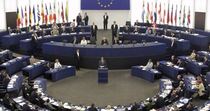
The European Parliament (EP) on Thursday called for an immediate and unconditional end to the blockade imposed on the Gaza Strip and condemned the Israeli killing of peaceful protesters near Gaza's eastern border over the past three weeks.
The Parliament during its Thursday session passed a resolution by a majority of 524 votes (nearly 70% of the EP members) to conduct transparent and independent investigations into the crimes committed against the protesters taking part in the Great March of Return.
The resolution stressed the Palestinians' right to peaceful protest, called for utmost restraint and underlined that priority must be to avoid any further escalation of violence and loss of life.
The EP expressed deep concern over the UN reports that the Gaza Strip will become uninhabitable by 2020.
It also praised the aid and services provided by UNRWA at many levels to about 1,3 million Palestinian refugees in the region.
The resolution reaffirmed that the main goal of the European Union is to achieve a two-state solution to the Palestinian-Israeli conflict on the 1967 borders with Jerusalem as a joint capital.
Thousands of Palestinians have taken part in the Great March of Return launched since 30th March along Gaza's border with the 1948 occupied territories in demand of the Palestinian refugees' right of return.
At least 35 Palestinians have been killed and about 3,100 injured by the Israeli gunfire deliberately targeting peaceful protesters.
A tightened blockade has been imposed by Israel on the Gaza Strip since 2007 causing unprecedented deterioration in the living conditions in the coastal enclave as well as high rates of unemployment and poverty.
The Palestinian Authority (PA) president Mahmoud Abbas in April 2017 decided to wage a set of punitive measure against Gaza to force Hamas to hand over the administration of the territory to the PA government.
The measures included cutting 30%-50% of the salaries of PA employees in Gaza, forcing some of them into early retirement, reducing power supplies and halting medical referrals.
The Parliament during its Thursday session passed a resolution by a majority of 524 votes (nearly 70% of the EP members) to conduct transparent and independent investigations into the crimes committed against the protesters taking part in the Great March of Return.
The resolution stressed the Palestinians' right to peaceful protest, called for utmost restraint and underlined that priority must be to avoid any further escalation of violence and loss of life.
The EP expressed deep concern over the UN reports that the Gaza Strip will become uninhabitable by 2020.
It also praised the aid and services provided by UNRWA at many levels to about 1,3 million Palestinian refugees in the region.
The resolution reaffirmed that the main goal of the European Union is to achieve a two-state solution to the Palestinian-Israeli conflict on the 1967 borders with Jerusalem as a joint capital.
Thousands of Palestinians have taken part in the Great March of Return launched since 30th March along Gaza's border with the 1948 occupied territories in demand of the Palestinian refugees' right of return.
At least 35 Palestinians have been killed and about 3,100 injured by the Israeli gunfire deliberately targeting peaceful protesters.
A tightened blockade has been imposed by Israel on the Gaza Strip since 2007 causing unprecedented deterioration in the living conditions in the coastal enclave as well as high rates of unemployment and poverty.
The Palestinian Authority (PA) president Mahmoud Abbas in April 2017 decided to wage a set of punitive measure against Gaza to force Hamas to hand over the administration of the territory to the PA government.
The measures included cutting 30%-50% of the salaries of PA employees in Gaza, forcing some of them into early retirement, reducing power supplies and halting medical referrals.
19 apr 2018
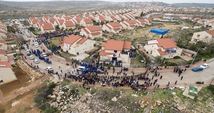
A Ramallah hospital amputated, on Thursday, the left leg of Gaza child Abdul Rahman Noufal, aged 13, from Nuseirat refugee camp, who was shot in the leg with an explosive bullet that ruptured his bones during protests at the Gaza border with Israel, according to family members.
Noufal underwent surgery at a Gaza hospital, following his injury, where doctors mulled over the possibility of amputating his leg but decided to wait and see if there were other options.
Noufal’s father, Yamen, appealed with PA president Mahmoud Abbas to intervene to get his son to receive medical treatment in Ramallah, to save his leg, because Gaza hospitals were not capable of it.
Abbas called on Civil Affairs head Hussein al-Sheikh to immediately get in contact with the Israeli authorities to get a permit for Noufal to leave Gaza and travel to Ramallah for medical treatment.
Israel agreed. on Wednesday, to allow Noufal to leave Gaza for medical treatment in Ramallah, according to the Civil Affairs Authority.
According to WAFA, it said in a statement that, following intervention with the Israeli authorities on behalf of Abdul Rahman Noufal, Israel has agreed to grant the child a permit to leave Gaza, to receive medical treatment at a Ramallah hospital.
Noufal arrived at Ramallah’s Istishari Hospital on Wednesday evening. He was accompanied by his grandmother.
However, after doctors realized that keeping his leg would endanger his life, they decided to amputate it, according to Noufal’s parents.
Noufal underwent surgery at a Gaza hospital, following his injury, where doctors mulled over the possibility of amputating his leg but decided to wait and see if there were other options.
Noufal’s father, Yamen, appealed with PA president Mahmoud Abbas to intervene to get his son to receive medical treatment in Ramallah, to save his leg, because Gaza hospitals were not capable of it.
Abbas called on Civil Affairs head Hussein al-Sheikh to immediately get in contact with the Israeli authorities to get a permit for Noufal to leave Gaza and travel to Ramallah for medical treatment.
Israel agreed. on Wednesday, to allow Noufal to leave Gaza for medical treatment in Ramallah, according to the Civil Affairs Authority.
According to WAFA, it said in a statement that, following intervention with the Israeli authorities on behalf of Abdul Rahman Noufal, Israel has agreed to grant the child a permit to leave Gaza, to receive medical treatment at a Ramallah hospital.
Noufal arrived at Ramallah’s Istishari Hospital on Wednesday evening. He was accompanied by his grandmother.
However, after doctors realized that keeping his leg would endanger his life, they decided to amputate it, according to Noufal’s parents.
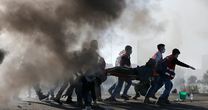
A Palestinian young man was shot and critically injured by the Israeli occupation forces in his head on Thursday evening east of Jabalia refugee camp, north of the blockaded Gaza Strip.
Local medics said an 18-year-old boy sustained serious injuries in his head and was evacuated to the Indonesian Hospital in Jabalia for urgent treatment.
The Israeli forces also showered the Awda camp, east of Jabalia, with teargas canisters, resulting in several suffocation cases.
Tension has reached a zenith along Gaza’s borderland as the Israeli military has stepped up aggressions against Palestinian protesters who have joined the Great March of Return rallies, ongoing since March 30.
Local medics said an 18-year-old boy sustained serious injuries in his head and was evacuated to the Indonesian Hospital in Jabalia for urgent treatment.
The Israeli forces also showered the Awda camp, east of Jabalia, with teargas canisters, resulting in several suffocation cases.
Tension has reached a zenith along Gaza’s borderland as the Israeli military has stepped up aggressions against Palestinian protesters who have joined the Great March of Return rallies, ongoing since March 30.
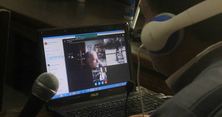
Noted American professor and writer Norman Finkelstein has called on the Palestinians to focus on human-media material during coverage of March of Return protests in Gaza in order to force Israel into a corner and make it end its blockade.
This came during a meeting and news conference held on Wednesday by the House of Wisdom for Consulting and Settlement of Disputes in Gaza, with the participation of thinkers, professors, activists and coordinators of the March of Return committees.
Norman pointed out that the most influential newspaper in the US and a staunch advocate of Israel, “The New York Times, published an interesting editorial recently in which it directed a lot of criticism at Israel and described its army minister Avigdor Lieberman as a liar and criminal.
The professor described the New York Times’ criticism of Israel as an important development, and urged the Palestinians to use the media to focus on the humanitarian aspects of their protests in Gaza so as to corner Israel and make the world take action against its blockade on the population.
He called for serious thinking by the Palestinians on how to spotlight their daily struggle over other Middle East news, affirming that Israel exploits the international media preoccupation with major events to commit atrocities against the Palestinians.
For his part, spokesman for the International March of Return Coordination Committee Isam Hammad said that the return marches are not confined to Gaza, but it is an issue that concerns all Palestinian refugees at home and abroad.
Hammad added that US president Donald Trump’s recent decisions on Occupied Jerusalem and UNRWA, the ongoing talk about the deal of the century, and Israel’s practices made the Palestinian refugees in a state of deep despair and gave them a strong impetus to participate in the March of Return protests.
This came during a meeting and news conference held on Wednesday by the House of Wisdom for Consulting and Settlement of Disputes in Gaza, with the participation of thinkers, professors, activists and coordinators of the March of Return committees.
Norman pointed out that the most influential newspaper in the US and a staunch advocate of Israel, “The New York Times, published an interesting editorial recently in which it directed a lot of criticism at Israel and described its army minister Avigdor Lieberman as a liar and criminal.
The professor described the New York Times’ criticism of Israel as an important development, and urged the Palestinians to use the media to focus on the humanitarian aspects of their protests in Gaza so as to corner Israel and make the world take action against its blockade on the population.
He called for serious thinking by the Palestinians on how to spotlight their daily struggle over other Middle East news, affirming that Israel exploits the international media preoccupation with major events to commit atrocities against the Palestinians.
For his part, spokesman for the International March of Return Coordination Committee Isam Hammad said that the return marches are not confined to Gaza, but it is an issue that concerns all Palestinian refugees at home and abroad.
Hammad added that US president Donald Trump’s recent decisions on Occupied Jerusalem and UNRWA, the ongoing talk about the deal of the century, and Israel’s practices made the Palestinian refugees in a state of deep despair and gave them a strong impetus to participate in the March of Return protests.
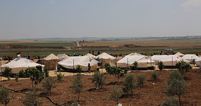
The National Authority for the March of Return said it moved its protest tent camps 50 meters closer to the eastern border fence with the Israeli occupied territory.
In a press release, the March of Return Authority stated that “as a continuation of the national program of ‘the marches of return and breaking of the siege’ and as a message of determination from our people to the world that they will continue to move forward towards their legitimate and inalienable goals, we declare that the camps of return have been relocated 50 meters ahead.”
It added that this move would be the first to be taken to confirm further the Palestinian people’s right to return to their homes and their rejection of the [US-backed] deal of the century and the conspiracy of the alternate homeland.
In a press release, the March of Return Authority stated that “as a continuation of the national program of ‘the marches of return and breaking of the siege’ and as a message of determination from our people to the world that they will continue to move forward towards their legitimate and inalienable goals, we declare that the camps of return have been relocated 50 meters ahead.”
It added that this move would be the first to be taken to confirm further the Palestinian people’s right to return to their homes and their rejection of the [US-backed] deal of the century and the conspiracy of the alternate homeland.
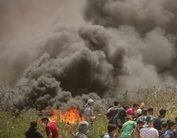
Israeli soldiers injured, Wednesday, several Palestinians in the Gaza Strip, after the army opened fire at the “al-Awdah” (The Return) protest camps, near the border fence in the besieged Gaza Strip.
Medical sources said several Palestinians were shot with live fire along the border area, in the eastern part of the Gaza Strip.
They added that the soldiers also shot two Palestinians with live fire in Khuza’a town east of Khan Younis, in southern Gaza Strip.
In addition, the soldiers shot a Palestinian with a live round in his arm, and another in his leg, after the army opened fire on protesters who dragged sections of the border fence.
Many Palestinians suffered the effects of teargas inhalation after the soldiers attacked protesters east of Gaza, while a young man was shot with a live round in his shoulder.
Furthermore, the soldiers shot a child with a live round, east of the al-Boreij refugee camp, in central Gaza.
In related news, the army fired an artillery shell at an observation post run by the Al-Qassam Brigades, the armed wing of Hamas, east of al-Boreij, after the soldiers claimed shots were fired at a military vehicle driving across the border fence.
Medical sources said several Palestinians were shot with live fire along the border area, in the eastern part of the Gaza Strip.
They added that the soldiers also shot two Palestinians with live fire in Khuza’a town east of Khan Younis, in southern Gaza Strip.
In addition, the soldiers shot a Palestinian with a live round in his arm, and another in his leg, after the army opened fire on protesters who dragged sections of the border fence.
Many Palestinians suffered the effects of teargas inhalation after the soldiers attacked protesters east of Gaza, while a young man was shot with a live round in his shoulder.
Furthermore, the soldiers shot a child with a live round, east of the al-Boreij refugee camp, in central Gaza.
In related news, the army fired an artillery shell at an observation post run by the Al-Qassam Brigades, the armed wing of Hamas, east of al-Boreij, after the soldiers claimed shots were fired at a military vehicle driving across the border fence.
18 apr 2018
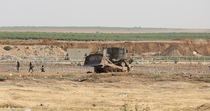
The Israeli occupation forces on Tuesday evening rolled into the eastern borders of Gaza city and re-installed the barbed wire after anti-occupation youth removed parts of it during Friday’s mass-protests.
A flock of Israeli military vehicles moved 100 meters into the besieged Gaza Strip and repaired the removed parts of the border fence.
On Friday Palestinian anti-occupation youth removed parts of the barbed wire separating the Gaza Strip from territories occupied in 1948 east of Shuja’iya neighborhood, in Gaza.
Over the past several weeks thousands of Palestinians have staged peaceful protests along the border fence, demanding hundreds of thousands of Palestinian refugees who were displaced from their homes be allowed to return.
The so-called “ Great March of Return” is set to climax on May 15, when the Palestinians will mark 70 years since the “nakba” (“catastrophe” in Arabic), which culminated in the displacement of thousands of Palestinians from their motherland—Palestine.
A flock of Israeli military vehicles moved 100 meters into the besieged Gaza Strip and repaired the removed parts of the border fence.
On Friday Palestinian anti-occupation youth removed parts of the barbed wire separating the Gaza Strip from territories occupied in 1948 east of Shuja’iya neighborhood, in Gaza.
Over the past several weeks thousands of Palestinians have staged peaceful protests along the border fence, demanding hundreds of thousands of Palestinian refugees who were displaced from their homes be allowed to return.
The so-called “ Great March of Return” is set to climax on May 15, when the Palestinians will mark 70 years since the “nakba” (“catastrophe” in Arabic), which culminated in the displacement of thousands of Palestinians from their motherland—Palestine.
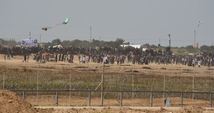
The Israeli occupation army claimed that a homemade firebomb tied to a kite, which were flown by Palestinians from Gaza, landed in a border field near Kibbutz Be’eri and caused fire on Wednesday.
According to Israel’s Channel 14, Israeli firefighters extinguished a fire near Kibbutz Be’eri, where a burnt kite was found.
A Palestinian Information Center (PIC) correspondent reported seeing a large green area aflame in the lands surrounding the “Camera” military post east of Juhor ad-Dik.
Palestinian protesters rallying in Gaza border areas started recently to attach Molotov cocktails to kites and fly them over the security fence to spark several fires in cross-border areas
At least four such kites were discovered in the vicinity of fires near the border fence. The blazes only caused damage to fields.
According to Israel’s Channel 14, Israeli firefighters extinguished a fire near Kibbutz Be’eri, where a burnt kite was found.
A Palestinian Information Center (PIC) correspondent reported seeing a large green area aflame in the lands surrounding the “Camera” military post east of Juhor ad-Dik.
Palestinian protesters rallying in Gaza border areas started recently to attach Molotov cocktails to kites and fly them over the security fence to spark several fires in cross-border areas
At least four such kites were discovered in the vicinity of fires near the border fence. The blazes only caused damage to fields.
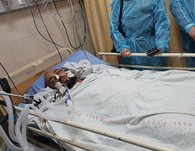
A Palestinian journalist from Gaza, one of the over 2,000 Palestinians wounded in the past 18 days by Israeli forces, arrived in a coma to Ramallah General Hospital Monday, after repeated delays of his transfer by Israeli authorities and the denial of treatment by Israeli hospitals.
Ahmad Abu Hussein, a photojournalist from Gaza, was shot in the head on Friday April 13th by Israeli snipers stationed at the border between Gaza and Israel. He was hit with an exploding bullet, a banned type of live fire that exlodes on impact, causing severe internal injuries.
The head of the Palestinian Journalists’ Syndicate, Nassar Abu Bakr, criticized the delay in the transfer of the patient, telling reporters from the Ma’an News Agency, “The Israeli authorities committed two crimes against Abu Hussein, one when injuring him with an explosive bullet in the head and another when delaying his transfer from Gaza hospitals to Ramallah, as if the occupation insists on killing him.”
Abu Bakr said that specialized Israeli hospitals were better equipped to treat the severely wounded journalist, but none would accept to have him transferred. So he was sent to Ramallah General Hospital in the West Bank. He added that only through ‘strenuous efforts’ by a number of Palestinian officials was this transfer made possible.
Dozens of journalists gathered in front of Ramallah General Hospital in solidarity with their wounded colleague, when he arrived at the hospital early Monday morning.
At least ten Palestinian journalists have been among those targeted by Israeli forces in their attacks on non-violent protests in Gaza over the past three weeks. On April 6th alone, six journalists were shot, and one was killed – 30-year-old Yasser Murtaja, who was wearing a clearly labeled PRESS flak jacket.
Ahmad Abu Hussein, a photojournalist from Gaza, was shot in the head on Friday April 13th by Israeli snipers stationed at the border between Gaza and Israel. He was hit with an exploding bullet, a banned type of live fire that exlodes on impact, causing severe internal injuries.
The head of the Palestinian Journalists’ Syndicate, Nassar Abu Bakr, criticized the delay in the transfer of the patient, telling reporters from the Ma’an News Agency, “The Israeli authorities committed two crimes against Abu Hussein, one when injuring him with an explosive bullet in the head and another when delaying his transfer from Gaza hospitals to Ramallah, as if the occupation insists on killing him.”
Abu Bakr said that specialized Israeli hospitals were better equipped to treat the severely wounded journalist, but none would accept to have him transferred. So he was sent to Ramallah General Hospital in the West Bank. He added that only through ‘strenuous efforts’ by a number of Palestinian officials was this transfer made possible.
Dozens of journalists gathered in front of Ramallah General Hospital in solidarity with their wounded colleague, when he arrived at the hospital early Monday morning.
At least ten Palestinian journalists have been among those targeted by Israeli forces in their attacks on non-violent protests in Gaza over the past three weeks. On April 6th alone, six journalists were shot, and one was killed – 30-year-old Yasser Murtaja, who was wearing a clearly labeled PRESS flak jacket.
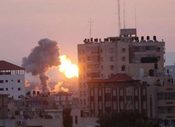
Israeli soldiers fired, on Wednesday at dawn, at least two artillery shells into Palestinian lands, close to the border fence east of Khuza’a town, east of Khan Younis, in the southern part of the Gaza Strip, wounding five Palestinians, including one who suffered a serious injury.
Media sources said the soldiers, stationed across the border fence east of Khuza’a town, fired at least two shells at Palestinians who approached the border fence, wounding five; one seriously.
They added that the soldiers also fired several live rounds at Red Crescent ambulances and medics who rushed to the scene.
On Tuesday evening, the soldiers shot and injured five Palestinians, including one child, during a nonviolent procession near the border fence.
The army also fired artillery shells into a site, east of the al-Boreij refugee camp, in central Gaza.
* 8 apr 2018: Haaretz: Israel may strike Hamas targets to stop border protests
Media sources said the soldiers, stationed across the border fence east of Khuza’a town, fired at least two shells at Palestinians who approached the border fence, wounding five; one seriously.
They added that the soldiers also fired several live rounds at Red Crescent ambulances and medics who rushed to the scene.
On Tuesday evening, the soldiers shot and injured five Palestinians, including one child, during a nonviolent procession near the border fence.
The army also fired artillery shells into a site, east of the al-Boreij refugee camp, in central Gaza.
* 8 apr 2018: Haaretz: Israel may strike Hamas targets to stop border protests
